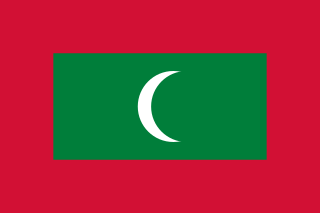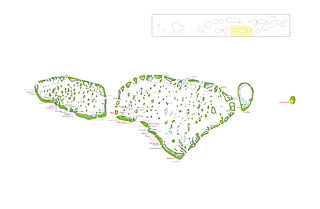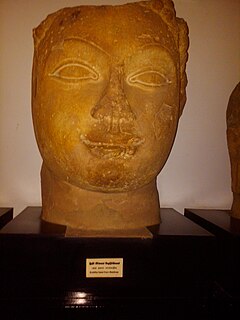Below is a list of museums in the Maldives .
Below is a list of museums in the Maldives .

Maldives, officially the Republic of Maldives, is an archipelagic country in the Indian subcontinent of Asia, situated in the Indian Ocean. It lies southwest of Sri Lanka and India, about 750 kilometres from the Asian continent's mainland. The chain of 26 atolls stretches from Ihavandhippolhu Atoll in the north to Addu Atoll in the south. Comprising a territory spanning roughly 90,000 square kilometres (35,000 sq mi) including the sea, land area of all the islands comprises 298 square kilometres (115 sq mi), Maldives is one of the world's most geographically dispersed sovereign states and the smallest Asian country as well as one of the smallest Muslim-majority countries by land area and, with around 557,751 inhabitants, the 2nd least populous country in Asia. Malé is the capital and the most populated city, traditionally called the "King's Island" where the ancient royal dynasties ruled for its central location.

The history of the Maldives is intertwined with the history of the broader Indian subcontinent and the surrounding regions, comprising the areas of South Asia and Indian Ocean; and the modern nation consisting of 26 natural atolls, comprising 1194 islands. Historically, the Maldives had a strategic importance because of its location on the major marine routes of the Indian Ocean. The Maldives' nearest neighbours are the British Indian Ocean Territory, Sri Lanka and India. The United Kingdom, Sri Lanka and some Indian kingdoms have had cultural and economic ties with the Maldives for centuries. In addition to these countries, Maldivians also traded with Aceh and many other kingdoms in, what is today, Indonesia and Malaysia. The Maldives provided the main source of cowrie shells, then used as a currency throughout Asia and parts of the East African coast. Most probably Maldives were influenced by Kalingas of ancient India who were earliest sea traders to Sri Lanka and the Maldives from India and were responsible for the spread of Buddhism. Stashes of Chinese crockery found buried in various locations in the Maldives also show that there was direct or indirect trade contact between China and the Maldives. In 1411 and 1430, the Chinese admiral Zheng He 鄭和 visited the Maldives. The Chinese also became the first country to establish a diplomatic office in the Maldives, when the Chinese nationalist government based in Taipei opened an embassy in Malé in 1966. This office has since been replaced by the embassy of the People's Republic of China.

Malé is the capital and most populous city in the Republic of Maldives. With a population of 252,768 and an area of 8.30 square kilometres (3.20 sq mi), it is also one of the most densely populated cities in the world. The city is geographically located at the southern edge of North Malé Atoll. Administratively, the city consists of a central island, an airport island, and four other islands governed by the Malé City Council.

Islam is the state religion of Maldives. The 2008 Constitution "Fehi Ganoon" clearly states the significance of the Islamic law in the country. The constitution requires that citizenship status be based on adherence to the state religion.

Kaafu Atoll is the code name given to an administrative division in the Republic of Maldives which consists of the geographical atolls of Kaashidhoo Island, Gaafaru, North Malé Atoll and South Malé Atoll. As the two Malé Atolls are the main islands of the administrative district, the entire Kaafu Atoll administrative division is officially named Malé Atoll or Malé Atolhu in the Maldivian language, Dhivehi.

Alif Alif Atoll is an administrative division of the Maldives. It was created on March 1, 1984, combining northern section of Ari Atoll, the small Rasdhukuramathi Atoll, and the isolated island of Thoddoo. Many of the islands in this atoll have been inhabited since ancient times and have archaeological remains from the Maldivian Buddhist period.

Laamu Atoll is an administrative division of the Maldives. It corresponds to the natural atoll of the same name. The administrative capital is Fonadhoo Island.

Gaafu Dhaalu is an administrative district of the Maldives formed by the southwestern section of Huvadhu Atoll. It was created on February 8, 1962 when Huvadhu Atoll was divided into two districts. Gaafu Dhaalu corresponds to the Southwestern section of this large natural atoll, south of the line extending between the channels of Footukandu and Vaarulu Kandu. The capital of this region is Thinadhoo. There are 153 islands in this district, 10 of which are inhabited. This district is located about 340 kilometers south of the capital Malé.

The President of the Maldives is the head of state and head of government of the Republic of Maldives and the commander-in-chief of the Maldives National Defence Force.
Traditionally children aged three and up in the Maldives were educated in traditional schools known as "edhurge", generally using a single large room or the shelter of tree. The children learn simple arithmetic, Dhivehi and some Arabic, and practice reciting the Qur'an. These private schools no longer exist, as western style schools replaced them in the 1980s-1990s·

Dhives Akuru or Divehi Akuru, is a script formerly used to write the Maldivian language. This script was called Dives Akuru by H. C. P. Bell who studied Maldive epigraphy when he retired from the British government service in Colombo and wrote an extensive monograph on the archaeology, history and epigraphy of the Maldive islands.

Established on the National Day of the Maldives, the first National Museum of the country was opened on 11 November 1952, by the Prime Minister at the time, Mohamed Amin Didi.

Buddhism was the predominant religion in the Maldives until at least the 12th century CE. It is not clear how and when Buddhism was introduced into the islands.

The Maldives first participated at the Olympic Games in 1988, it sent athletes to compete in every Summer Olympic Games The nation never won an Olympic medal and has not participated in the Winter Olympic Games.
The 2008 Constitution of Maldives designates Sunni Islam as the state religion. Only Sunni Muslims are allowed to hold citizenship in the country and citizens may practice Sunni Islam only. Non-Muslim citizens of other nations can practice their faith only in private and are barred from evangelizing or propagating their faith. All residents are required to teach their children the Muslim faith. The president, ministers, parliamentarians, and chiefs of the atolls are required to be Sunni Muslims. Government regulations are based on Islamic law. Only certified Muslim scholars can give fatawa.
The Maldives women's national football team was first formed in 2003. The team represents Maldives in international women's football and thus falls under the governance of the Football Association of Maldives. The team played its first official international match against Myanmar on 1 October 2004.

China–Maldives relations refer to foreign relations between China and the Maldives. China has an embassy in Malé which opened in November 2011 and the Maldives has an embassy in Beijing which opened in 2009. Diplomatic relations were established in 1972.
A museum is an institution that cares for (conserves) a collection of artifacts and other objects of artistic, cultural, historical, or scientific importance and makes them available for public viewing through exhibits that may be permanent or temporary. According to Museums of the World, there are about 55,000 museums in 202 countries. The International Council of Museums comprises 30,000 members in 137 countries.